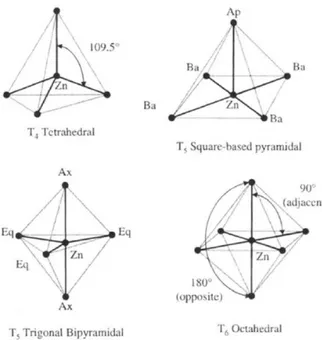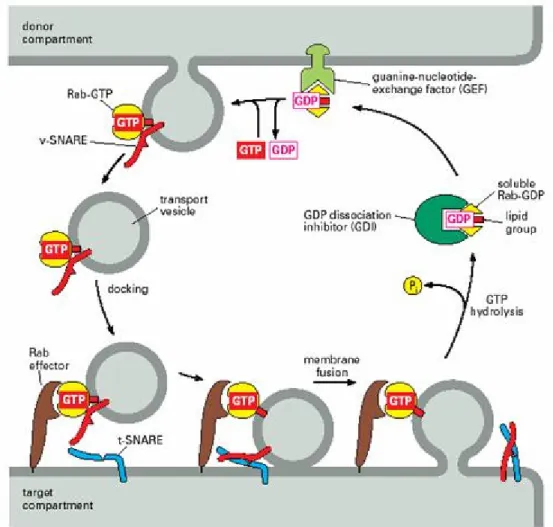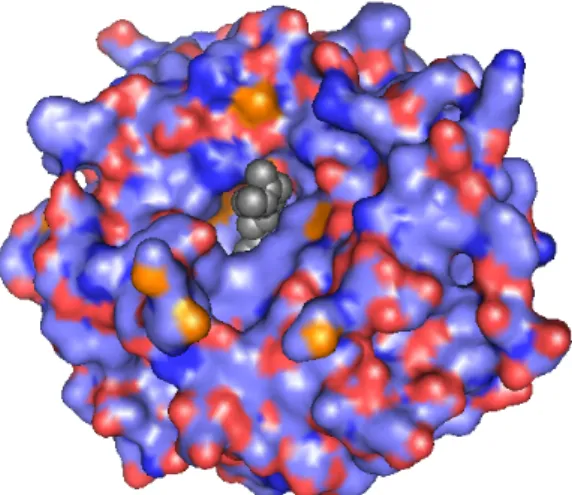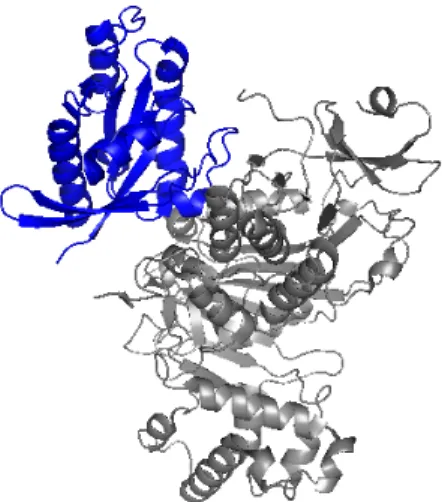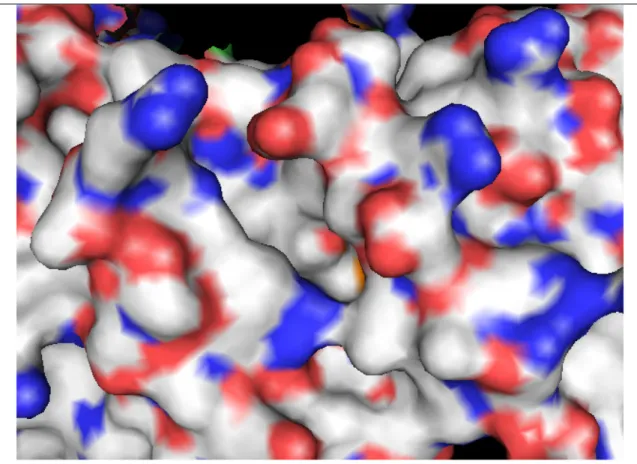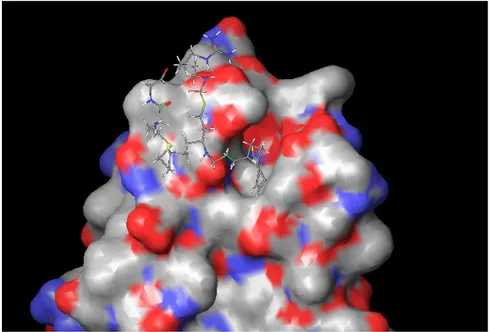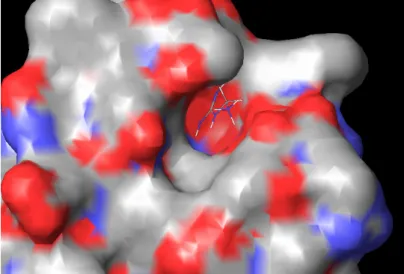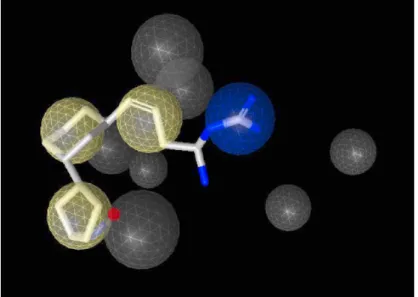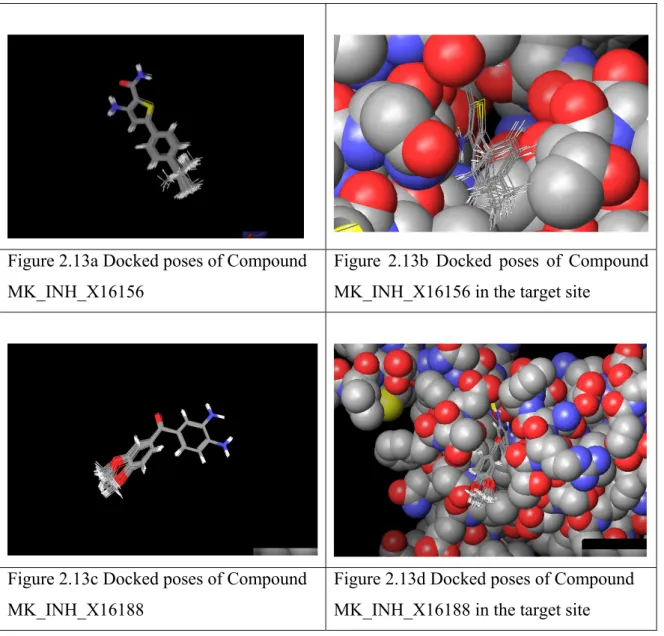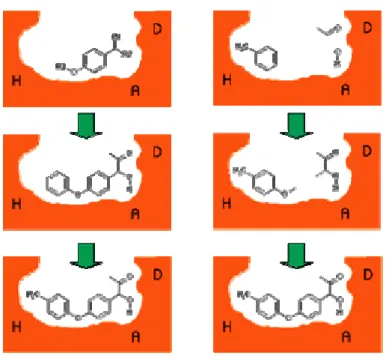Targeting REP:GGTase-II Interaction and Finding New Means to Predict the
Protein:Ligand Interactions
DISSERTATION
zur Erlangung des akademischen Grades Doktor der Naturwissenschaften
(Dr. rer. nat.)
vorgelegt von
Mahesh Kulharia B.Sc., M.Sc. in Biotechnology,
aus Hissar, India
eingereicht bei der Fakultät Chemie
der Technische Universität Dortmund
Erstgutachter: Prof. Dr. Alfons Geiger
Zweitgutachter: Prof. Dr. Roger Goody
Dritter Prüfer: Prof. Dr. Martin Englehard
CONTENTS Contents
Symbols and Abbreviations Acknowledgements
1.0 Introduction
i iv
v 1 1.1 General Background
1.2 Computer aided drug design
1.3 Protein-protein interactions: General aspects
1.4 Protein-protein contacts: Composition and nature of interactions 1.5 Thermodynamics and kinetics of protein-ligand interactions 1.6 Scoring functions
1.7 Molecular mechanics-based scoring functions 1.7.1 Bonded energy terms
1.7.2 Non-bonded energy term 1.8 Empirical scoring functions
1.9 Knowledge-based scoring functions
1.10 Treatment of divalent ions (such as zinc) in scoring function 1.11 Virtual screening
1.12 Docking and scoring
1.13 Predicting Ligand binding sites 1.14 Predicting protein-ligand affinity 1.15 Aims and objectives
1.16 Thesis outline
2.0 Structure-based pharmacophore design and targeting REP- GGTase-II interaction interface
1 2 2 3 3 4 5 5 6 7 8 9 10 11 12 14 16 17 21 2.1 Abstract
2.2 Introduction
2.3 Biological perspective
2.4 Understanding the enzyme system of Rab prenylation 2.4.1 Rab proteins
2.4.2 GGTase-II
2.4.3 Rab Escort Protein 2.4.4 Rab-REP interface 2.4.5 REP-GGTase-II interface 2.5 Targeting the enzyme system 2.5.1 Putative targets in enzyme system 2.5.1.1 Ligand binding sites
21
22
23
24
24
25
28
29
30
33
33
33
2.7.2 Docking based identification of stable “anchor” fragment for growing molecules
2.7.3 Molecules generated by growing the guanidine tail
2.7.4 Diversification of the hydrophobic part of lead_molecule_1;
Pharmacophore generation; Virtual screening and Assay results 2.8 Conclusions
2.9 References 2.10 Appendices
3.0 InCa-SiteFinder: A method for structure based prediction of carbohydrate binding sites on proteins
37 38 39 41 43 45 51 3.1 Abstract
3.2 Introduction 3.3 Methods
3.3.1 Construction of dataset for propensity calculation 3.3.2 Calculation of amino acid propensities
3.3.3 InCa-SiteFinder
3.3.4 Definition of a true carbohydrate binding site 3.3.5 Optimisation of InCa-SiteFinder performance 3.3.6 Calculation of sensitivity and specificity 3.3.7 Optimisation of InCa-SiteFinder
3.3.7.1 Determination of PSSBC cut-off for classifying a region as a site 3.3.7.2 Determination of differential propensity score cut-off for carbohydrate binding site
3.3.8 Dataset for evaluation of the ability of the InCa-SiteFinder to
distinguish between the carbohydrate binding sites and drug-like compound binding sites
3.4 Results and discussion
3.4.1 Amino acid propensity to interact with carbohydrate molecule 3.4.2 10-fold cross-validation and optimisation of InCa-SiteFinder 3.4.3 Validation of optimised InCa-SiteFinder
3.4.4 Determination of PSSBC cut-off value
3.4.5 The importance of differential propensity score for the recognition of carbohydrate binding sites
3.4.6 Evaluation of DPS and threshold values 3.5 Some examples of site prediction 3.6 Conclusions
3.7 References 3.8 Appendices
51
52
54
54
54
55
57
57
58
59
59
60
60
61
61
62
65
66
66
68
69
71
73
76
4.0 An Information theory-based scoring function for the structure- based prediction of protein-ligand binding affinity
4.1 Abstract 4.2 Introduction 4.3 Methods
4.3.1 Construction of an atom pair contact database 4.3.2 Calculation of atomic contact preferences
4.3.3 Generation of a protein-water contact database and atomic solvation- desolvation measures
4.3.4 Protein-ligand test set 4.4 Results
4.4.1 Choice of scoring function 4.4.2 Choice of scoring parameters
4.4.3 Inclusion of Solvation effects and SIScoreJE 4.4.4 Comparison of different scoring functions 4.4.5 Identification of Near-Native Configurations 4.5 Discussion
4.6 Conclusions 4.7 References 4.8 Appendices
5.0 Conclusion Future Perspectives
80
80
81
83
84
88
89
89
90
90
92
94
98
99
101
103
104
107
113
115
Symbols and Abbreviations
Å Angstrom
CADD Computer Aided Drug Design CBP Carbohydrate Binding Propensity DPS Differential Propensity Score GDP Guanosine Diphosphate GGpp Geranylgeranyl Pyrophosphate GGTase Geranylgeranyl Transferase GTP Guanosine Triphosphate
HBA Hydrogen Bond Acceptor HBD Hydrogen Bond Donor IC50 Inhibition Concentration 50%
InCa Inositol-Carbohydrate LBDD Ligand-based Drug Design M Molar
nM nano Molar
NI Negative Ionisable
PSSBC Propensity Score of a Site to Bind Carbohydrates PSSBnC Propensity Score of a Site to Bind non Carbohydrates PI Positive Ionisable
RBP Rab Binding Platform REP Rab Escort Protein ScoreJE Score Joint Entropy
SIScoreJE Solvation Included Joint Entropy
SBDD Structure-based Drug Design
Acknowledgements
I would like to take this opportunity to convey my heartfelt thanks to the following people,
Prof. Roger Goody for sharing my problems and extending care and rock-solid support in times of need. His unwavering support has been an immense source of strength and hope.
Prof. Alfons Geiger for listening to my presentations and the valuable advice and guidance he provided during PhD.
Prof. Martin Englehard for taking out time to view my project work and for the kind words of support and encouragement.
Dr. Richard Jackson for burning midnight oil in helping me to realise the objectives we had set.
Dr. Alexey Rak and Dr. Olena Pylypenko for the help they extended in the initial stages of my work.
Prof. David Westhead for asking questions and giving good advice when needed.
I am grateful to my father, brother and wife Sarita for being there in times of rough sea.
Thanks Nagaraj and Gurpreet Singh for listening to my daily quota of ideas and giving me valuable advices on feasibility of some of the projects; Amit Sharma and Parbhu Dayal Jakhar for being close to my family in times of need. Harry Mathala for helping me with programming and providing me insights of molecular modelling.
Dr. Tetsuya Kitaguchi, Dr. Anne Adida, Dr. Sergei Mureev (Captain Barbossa) and
Chapter 1: Introduction
1.1 General Background
Drugs are single or combinations of small molecules with defined composition and specific pharmacological effect. The process of identification of new drugs is regulated by legal agencies like “Food and drug administration”. This process can be divided in to the phases of drug discovery and drug development. Drug discovery process involves the application of different conceptual strategies to obtain novel protein activity modulators, deduction of the mechanism of these compounds, lead demonstration and optimisation, in vivo proof of concept and simultaneous demonstration of a therapeutic index. Drug development begins when the drug molecule is put in phase I clinical trials.
On an average the time from conception of the targeting strategy to the grant of
approval by a regulatory authority for a new drug molecule is 10-15 years. It is estimated
majority of drug candidates fail along the way. This results in huge loss for consumers
(pharmacy companies pass their loss to patients) as the cost of bringing a new drug to
market is close to a billion dollars (Dimasi et al, 2000). Hence the a number of approaches
have been adopted to help distinguish the druggable targets from non-druggable ones. One of
the major goals of computational chemistry, or the rational design of compound libraries, is
to maximise diversity, to enhance the potential of finding active compounds in the initial
rounds of virtual screening programs. Drug discovery has traditionally required testing of
hundreds of individually synthesized and characterized chemicals; the new techniques of
virtual synthesis in computational chemistry, and virtual screening (VS) offer the possibility
of rapidly preparing and examining hundreds of compounds. This increased screening ability
dramatically increases the probability of finding a lead compound with the proper balance of
activity, specificity, safety, bioavailability, and stability to result in a successful new drug.
1.2 Computer-Aided Drug Design
Computer-Aided (Assisted) Drug Design (CADD) is a generic term used to address various computer-based drug design strategies. This field can broadly be divided into two categories (1) Ligand-Based Drug Design (LBDD) exploiting information of known actives and (2) Structure-Based Drug Design (SBDD) carried out in the presence of a protein structure. The important background relating to protein-ligand interactions is discussed below. Since the application of computational techniques have the objective of designing the small molecules and this we designed inhibitors for the disruption of REP:GGTase-II interaction, the general aspects of protein-protein interaction followed by concepts in current understanding about kinetic and thermodynamic aspects of protein-ligand binding are discussed. The general methods used in the process of CADD are discussed next i.e. virtual screening (VS), docking, and de novo drug design.
1.3 Protein-protein interaction: general aspects
Protein-protein interaction is the fundamental process for the functioning of the huge
number of processes in the living cells. Malfunctioning of any part of protein turnover
machinery can cause occurrence of non-native interactions that may lead to pathological
disorders such as Alzheimer’s disease. The regulation of protein-protein interaction is
mediated either through control of external conditions (such as pH and ionic strength) or by
the activity of other cellular proteins (example enzymes). An important feature of protein-
protein interaction is the variety in their interaction modes. The types of pits, grooves, voids
and pockets that can possibly be generated by the arrangement of amino acid side chains are
extremely diverse. Current approach for rational drug design involves the targeting the active
sites in a protein which leads to broad spectrum of effects. Moreover the targeting of enzyme
active sites by this approach is under effective as the mutations in active site coupled with
the cellular process have an inbuilt redundancy and alternative pathways generally can compensate the inhibition. In addition the knowledge about any starting compound for the inhibitor design is not straight forward as unlike the enzymes there is no small molecular substrate.
1.4 Protein-protein contacts: Composition and nature of interactions
Protein-protein interactions typically bury 1600Å 2 of the surface area at the interface (Buckingham, 2004). The interface is potentially rich in arginine, histidine, asparagine, tryptophan, tyrosine and serine (Davies, D.R. et al, 1996). Analysis of secondary structures in the interface areas showed that the random coil comprises 47% of the protein-protein interaction interface; 36% α-helix; 17% β-sheet (Nissinov, R 1997). The interaction forces are van der Waals, hydrophobic and electrostatic in nature. The degree of surface complementarity between interacting interfaces is dependent on the strength of complex.
Permanent complexes interfaces have a high surface complementarity whereas temporary complexes have less interfacial complementarity. (Jones S et al 1996).
1.5 Thermodynamics and kinetics of protein-ligand interactions
Protein-ligand interactions can be experimentally measured under thermodynamic equilibrium conditions from which the inhibition constant K i can be obtained (Equation 1.2).
The inhibition (or dissociation) constant describes the strength of protein-ligand binding as
mole/l. A ligand binds stronger to the receptor when the K i is small (e.g. nanomolar). If there
is less ligand present than the value of K i, then only a small proportion of the protein will be
associated with the ligand and a biological effect may be difficult to measure. IC 50 term gives
the ligand concentration at which the enzyme activity decreases to 50%. It is shown that both
IC 50 and K i characterise protein-ligand interactions in a similar way, so that the easily
(ΔH˚) and entropic contributions (TΔS˚) which can be measured experimentally by Isothermal Titration Calorimetry (ITC) or van’t Hoff analysis (Holdgate and Ward, 2005).
These experiments have shown that ΔG˚ and ΔH˚ are not directly correlated, thus enthalpy alone is not an adequate measure for binding affinity (Boehm and Klebe, 1996). Receptor [R] and ligand [L] associate and form a non-covalent, reversible receptor-ligand complex [LR] in solution under thermodynamic equilibrium conditions.
] [ ] [ ]
[ R + L ↔ RL 1.1
The experimentally determined inhibition constant (K i ) or dissociation constant (K D ) or reciprocal association constant (K A ) describes the relationship between bound and unbound molecules.
] [
] ][
[ 1
RL L R K K
K
A D
i = = = 1.2
The Gibb’s free energy of binding (ΔG˚) comprises an enthalpic (ΔH˚) and an entropic term (TΔS˚) where T is the temperature in Kelvin and R is the gas constant (1.987 cal /(K mole)).
ΔG˚ = -RT ln K A = RT ln K i = ΔH˚ - TΔS˚ 1.3
1.6 Molecular mechanics-based scoring functions
Computational methods such as docking are applied to identify the correct orientation
of the ligand in the binding site and estimate ligand binding affinities. These docking
protocols comprise of an algorithm for searching the conformational space to identify the
most probable orientation of a molecule in the binding pocket and a scoring function which
based functions (e.g. ChemScore, X-Score) or (3) knowledge-based potentials (e.g. PMF, DrugScore). These different types of scoring functions will be reviewed in the following sections.
1.7 Molecular mechanics-based scoring function
Molecular Mechanics (MM)-based scoring functions (also termed force field or first principle based methods) approximate binding affinity by summing individual contributions in a master equation. The terms used for different interaction types are based on physicochemical theory and should not be cross correlated with each other. These terms are often combined with solvation and entropic terms.
An example in terms of docking is the original DOCK 3.0 score (Meng et al., 1992). It is one of the earliest scoring functions and covers the principal contributions to binding: shape and electrostatics accounted for in terms of a van der Waals term and an electrostatic potential term. These separable terms are combined into a grid-based AMBER force-field scoring function which is computed at specific grid points according to the field generated by the receptor. The overall score is then calculated as the sum of ligand atom interactions at the grid points (using a interpolation scheme) assuming additivity of individual terms (Tame, 1999).
In contrast to time-consuming quantum mechanics methods, that describe molecules based
on their electron distribution by ab-initio or semi-empirical approaches, force fields or
molecular mechanics describe molecules reduced to their atoms and bonds i.e. as charged
atom centres, with masses assigned according to atomic weight connected by springs. They
usually comprise two energy components, one for the protein-ligand interaction and another
for the internal (conformational/strain) energy of the ligand (and sometimes the protein). The
protein conformational energy is often left out as usually only a single conformation is
considered during docking. MM-based scoring methods most often assume a common
Potential Energy = E bond + E angle + E dihedral + E elec + E vdw
(bonded) (non-bonded) 1.4
The total energy of a conformation comprises several energy terms (Brooks et al., 1983).
1.7.1 Bonded energy terms
The bonded energy terms comprise the bond (E bond ), bond angle (E angle ), dihedral (E dihedral ) and improper torsional potentials (E impr ), all together referred to as the bonded interactions (Equation 1.5). The bond and angle deformations (E bond , E angle ) are generally small. As such, deviations from equilibrium bond and angle values are treated with large energy penalties. The dihedral angle is defined by four atoms, with the torsion angle about the axis of the middle pair of atoms. The improper torsion potential is necessary to maintain chirality.
E bonded = ∑ k b (r - r 0 ) 2 + ∑ k θ (θ - θ 0 ) 2 + ∑ |k φ | - k φ cos(nφ)
bond angle dihedral 1.5
Internal energy terms k b, k θ, k φ are constants, r =bond length between two atoms (A, B), θ = bond angle between three atoms (A, B, C), φ = torsion angle between two planes defined by four atoms (A, B, C and B, C, D), n = number of least points at 360˚ rotation of B-C bond, r 0,
θ 0 are the equilibrium values of these variables.
1.7.2 Non-bonded energy term
Electrostatic energy (E vdw )
The electrostatic energy calculation is based on partial atomic charges. It can be calculated by applying Coulombs law. Setting the dielectric constant (ε) proportional to r is a standard procedure to mimic electrostatic shielding by solvent when it is not included explicitly (the calculation of additional solvent is CPU intensive). In the presence of solvent, a dielectric constant of 1 is used (i.e. the relative permittivity of free space). The experimentally derived dielectric constant is a bulk solvent property and depends on the polarisability of solvent molecules. It increases with highly polarisable solvents like water (ε
=80), reducing greatly the electrostatic interaction. In protein simulations without explicit solvent it usually takes as a value between 2 and 10, or 4r (known as a distance dependent dielectric).
The calculation of the non-bonded energy terms (Equation 1.6) takes up the majority of computing time for energy evaluation because it is proportional to n 2 and not n, as for other terms in Equation 1.6. It can be decreased by using a non-bonded cut-off radius at which the energy becomes zero. In this case, only atom pairs within the cut-off contribute to the calculated interaction energy. A switching function near the cut off distance is used to avoid discontinuity in the energy function and possible instability of the calculated energy.
E non-bonded =
( ) ∑ ( )
∑ = = ⎟ ⎟
⎠
⎞
⎜ ⎜
⎝
⎛ −
+
1
, 12 6
1 ,
4
j i
excl ij
ij ij
ij j
i excl
r q q
r B r
A
ij r
j i
